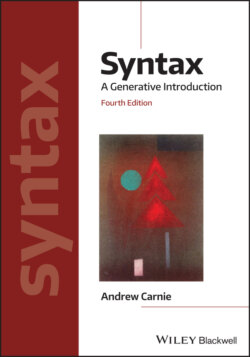Читать книгу Syntax - Andrew Carnie - Страница 13
1. SYNTAX AS SCIENCE – THE SCIENTIFIC METHOD
ОглавлениеFor many people, the study of language properly belongs in the humanities. That is, the study of language is all about the beauty of its usage in fine (and not so fine) literature and its impact on human culture. However, there is no particular reason, other than tradition, that the study of language should be confined to a humanistic approach. It is also possible to approach the study of language from a scientific perspective; this is the domain of linguistics. People who study literature often accuse linguists of abstracting away from the richness of good prose and obscuring the beauty of language. Nothing could be further from the truth. Most linguists, including the present author, enjoy nothing more than reading a finely crafted piece of fiction, and many linguists often study, as a sideline, the more humanistic aspects of language. This doesn’t mean, however, that one can’t appreciate and study the formal properties (or rules) of language and do it from a scientific perspective. The two approaches to language study are both valid; they complement each other; and neither takes away from the other.1
Science is perhaps one of the most poorly defined words of the English language. We regularly talk of scientists as people who study bacteria, particle physics, and the formation of chemical compounds, but ask your average Joe or Jill on the street what science means, and you’ll be hard pressed to get a decent definition. But among scientists themselves, science typically refers to a particular methodology for study: the deductive scientific method. The scientific method dates back to the ancient Greeks, such as Aristotle, Euclid, and Archimedes. The method involves observing some data, making some generalizations about patterns in the data, developing hypotheses that account for these generalizations, and testing the hypotheses against more data. Finally, the hypotheses are revised to account for any new data and then tested again. A flow chart showing the method is given in (1):
(1)
In syntax, we apply this methodology to sentence structure. Syntacticians start2 by observing data about the language they are studying, then they make generalizations about patterns in the data (e.g., in simple English declarative sentences, the subject precedes the verb). They then generate a hypothesis about these patterns and test the hypothesis against more syntactic data, and if necessary, go back and re-evaluate their hypotheses.
Hypotheses are only useful to the extent that they make predictions. A hypothesis that makes no predictions (or worse yet, predicts everything) is useless from a scientific perspective. In particular, the hypothesis must be falsifiable. That is, we must in principle be able to look for some data, which, if true, show that the hypothesis is wrong. This means that we are often looking for the cases where our hypotheses predict that a sentence will be grammatical (and it is not), or the cases where they predict that the sentence will be ungrammatical (contra to fact).
In syntax, hypotheses are called rules, and the group of hypotheses that describe a language’s syntax is called a grammar. The term grammar can strike terror into the hearts of people. But you should note that there are two ways to go about writing grammatical rules. One is to tell people how they should speak (this is of course the domain of English teachers and copy-editors); we call these kinds of rules prescriptive rules (as they prescribe how people should speak according to some standard). Some examples of prescriptive rules include “never end a sentence with a preposition”, “use whom not who” and “don’t split infinitives”. These rules tell us how we are supposed to use our language. The other approach is to write rules that describe how people actually speak, whether or not they are speaking “correctly”. These are called descriptive rules. Consider for a moment the approach we’re taking in this book. Which of the two types (descriptive or prescriptive) is more scientific? Which kind of rule is more likely to give us insight into how the mind uses language? We are going to focus on descriptive rules. This doesn’t mean that prescriptive rules aren’t important (in fact, in the problem sets section of this chapter you are asked to critically examine the question of descriptive vs. prescriptive rules), but for our purposes descriptive rules are more important.
You now have enough information to answer General Problem Sets GPS1 & 2, as well as Challenge Problem Set CPS1 at the end of this chapter. For practice try Workbook Exercise WBE1 in chapter1of The Syntax Workbook, 2nd Edition, an optional companion book to this text.
